2016 Annual Report for LNC14-357
Tomato Variety Trials for Flavor, Quality and Agronomic Performance, to Increase High-value Direct Marketing Opportunities for Farmers and On-farm Trialing Capacity
Summary
Many organic and low-input farmers in the Upper Midwest are using high tunnels (hoop houses) to extend the season for tomato production. We are using participatory research methods to evaluate tomato varieties for agronomic traits, disease resistance, flavor and quality for local and regional markets in the North Central Region. We compared tomato variety performance in high tunnels and open-field management, and developed a network of farmers who are evaluating varieties in on-farm trials. We assessed quality and flavor by using a combination of farmer evaluations, research staff evaluations and Madison area chef evaluations, in addition to several public taste tests at field days and other events.
The dramatically higher yield in the high tunnel was due to both an extended season and substantially lower foliar disease incidence in the high tunnel environment. Despite the generally held opinion that modern varieties are higher yielding and more disease resistant than heirlooms, while heirlooms are more flavorful, we found more variation among varieties within these groups than between them. In addition to our findings on tomato variety performance in the upper Midwest, we have improved our participatory trialing methodology to more meaningfully involve farmers and other experts in variety trialing research, and created a participatory trialing network for tomatoes and other crops in the upper Midwest.
Objectives/Performance Targets
- Conduct organic and low-input IPM field trials investigating selection of tomato varieties for optimal economic and environmental sustainability on two research stations and on 6 participating farms.
- Characterize varieties with acidity, Brix and nutritional measurements, and identify potential correlations with quality and flavor.
- Evaluate flavor for each variety with a panel of chefs currently sourcing local products.
- Provide data for breeders, researchers, farmers and seed companies to identify both promising varieties and traits needing improvement for the NCR.
- Develop a network of farmers, extension specialists and chefs interested in participatory research.
- Create an online database that will be easy for farmers to both access and contribute to, following the model of successful citizen science projects and participatory plant breeding trial methodology
Accomplishments/Milestones
We have successfully completed the trials on-station and on-farm and are expanding on-farm trials. The more flexible methodology for farmer participation we developed for last year has resulted in an increasing number of farmers interested in participating in these trials. We have continued to engage chefs and consumers in evaluation of variety flavor. These trialing methods and participatory network are being used for other crops as well, as part of the “Seed to Kitchen Collaborative”, https://dawson.horticulture.wisc.edu/chef-farmer-plant-breeder-collaboration/
We have published project results from the research station trials and flavor evaluations and are currently working on extension publications combining the on-station and on-farm variety trial results.
Objective 1. Conduct organic and low-input IPM field trials investigating selection of tomato varieties for optimal economic and environmental sustainability on two research stations and on 6 participating farms.
We completed the on-station variety trials comparing high-tunnel and field performance in certified organic conditions at the West Madison Agricultural Research Station and under organic management (non-certified) field conditions at the Rock County Extension Farm. Results from the 2014 preliminary trials and 2015 field season have been published as part of the Masters’ Thesis of Kitt Healy and as a peer-reviewed publication in Renewable Agriculture and Food Systems (publications and presentations list below). The on-farm trials were very successful in 2016, with 14 farmers participating, up from 5 farmers in 2015. In a continuation of this work, 20 farmers have agreed to participate in the 2017 on-farm tomato trials. We are currently conducting the project evaluation with farmers and plant breeders and have completed the evaluation with chefs. We have requested a no-cost extension to complete publication of the complete trial data, including data from 2016 and a look at the economics of different market classes of tomatoes in our trial and how much the earlier yields in the hoop house affect the gross revenue farmers receive, as tomato prices are often higher earlier in the season. We are also currently working on an extension bulletin which will summarize the results of three years of trial data from the research station, the on-farm trials and flavor evaluations.
Methods:
In 2016 we conducted the second year of two on-station variety trials, each of which included 20 varieties of tomatoes. These varieties were the same as those trialed in 2015, chosen based on data from preliminary trials in 2014. The trials were at the West Madison Agricultural Research Station, and the Rock County Extension Farm in Janesville, WI. At West Madison, we compared hoop house and open field production of all varieties, on certified organic land. At the Rock County Farm, we tested varieties in open field production, using organic practices on non-certified land. On-station trials were conducted as randomized complete block designs with the same check varieties (Big Beef and Pruden’s Purple) as in the 2014 screening trials.
Tomatoes were harvested weekly from mid July to mid October at West Madison, and three times from mid-September to early October at Rock County. At each harvest, tomatoes were sorted into “marketable” and “unmarketable” categories. Any fruits damaged by splitting, disease, insects, rodents or weather were considered unmarketable. Natural cat-facing on heirlooms or small dry cracks due to rapid growth were still considered marketable. Total weight and number of marketable tomatoes were recorded for each plot, as were total weight of unmarketable tomatoes and causes of damage. Perfectly ripe tomatoes were put aside for flavor evaluation and flavor components analysis. Disease ratings were taken three times during the season in each location.
Results:
The greatest difference was between tomatoes grown in the open-field and those in the hoophouse, with variety being a significant but lower in magnitude effect. The market category (heirloom parentage, crosses between heirloom and modern varieties, modern large slicers and modern small slicers) did not have a significant effect on yield or disease resistance, suggesting that the perception that heirloom tomatoes are lower yielding and more disease prone may not hold for all varieties in this category, and that there is more variation within these market categories than between them.
In the 2014 preliminary trials, marketable yield was 20% greater in the hoop house and in 2015, marketable yield was 45% higher in the hoop house (see figure 1). In 2016, marketable yield was over two times higher in the hoop house (preliminary data analysis). This difference was primarily due to greater disease in the field (Figure 2), including septoria, early blight, bacterial speck (in 2015) and extremely rainy conditions (in 2016). Varieties showed some differences in susceptibility to septoria and early blight, the two major foliar diseases, but these differences were much smaller than the effect of the management system (hoop house vs. open field).
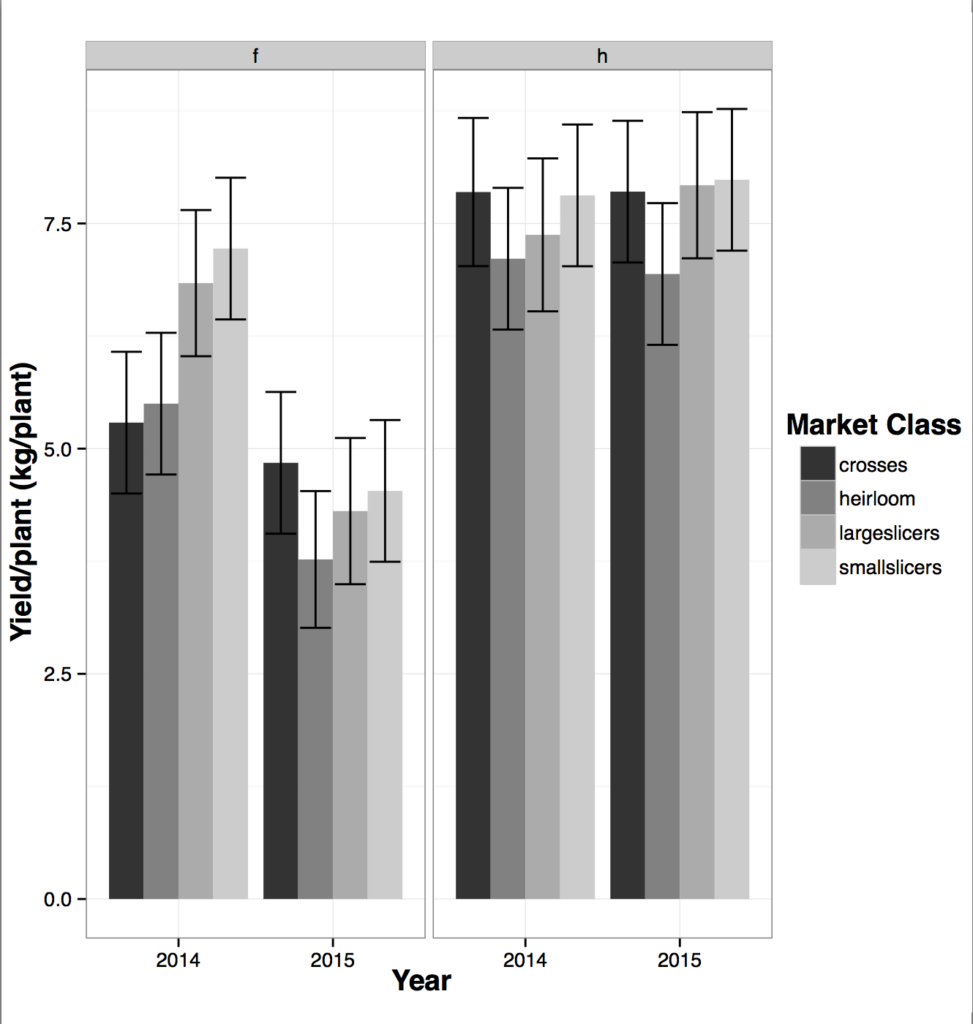 Fig. 1) Marketable yield per plant 2014-2015 for Field (f) and High Tunnel (h) environments, by market class. Figure from Healy et al. 2017.
Fig. 1) Marketable yield per plant 2014-2015 for Field (f) and High Tunnel (h) environments, by market class. Figure from Healy et al. 2017. 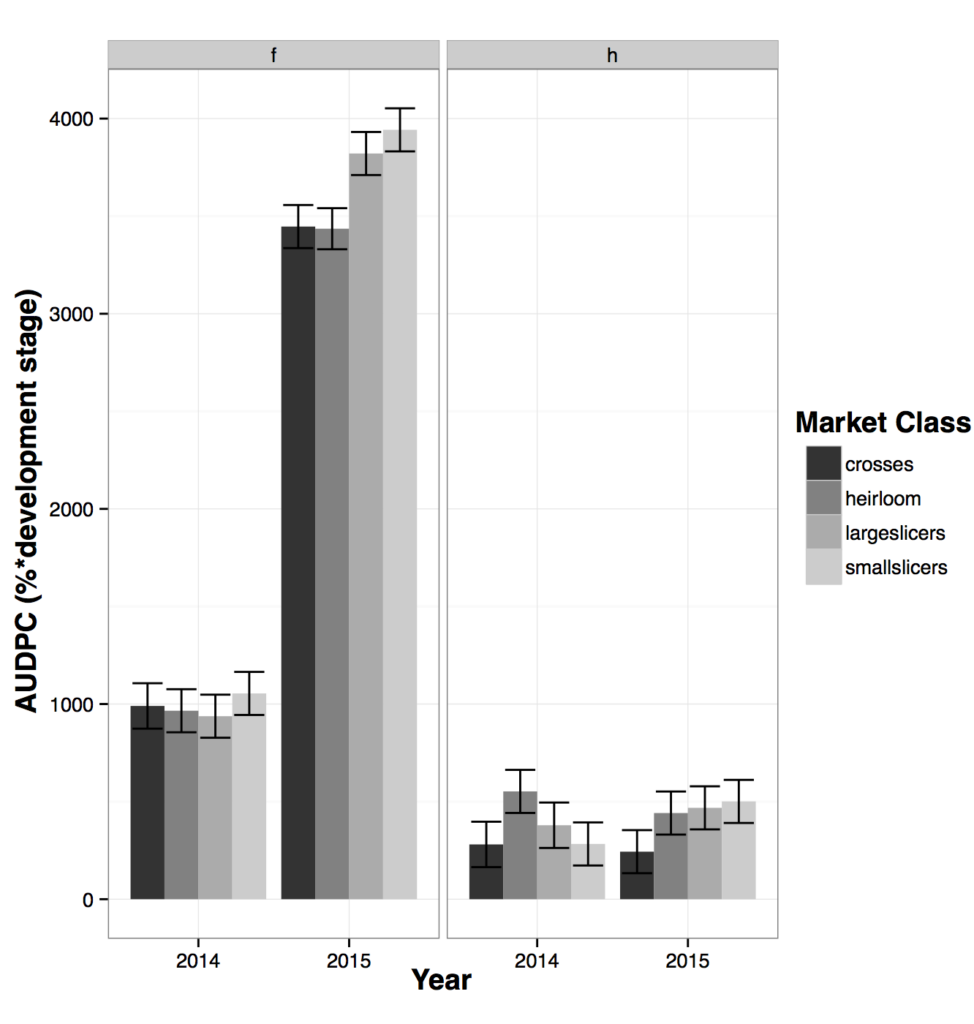 Fig. 2) Area Under the Disease Progress curve, 2014-2015 Field (f) and High Tunnel (h) tomatoes. Figure from Healy et al. 2017.
Fig. 2) Area Under the Disease Progress curve, 2014-2015 Field (f) and High Tunnel (h) tomatoes. Figure from Healy et al. 2017.
Data from these trials is available in summary form online at dawson.horticulture.wisc.edu
Objective 2. Characterize varieties with acidity, Brix and nutritional measurements, and identify potential correlations with quality and flavor.
We completed the on-station measurement of Brix and acidity, as well as the flavor evaluations by chefs and research staff. The ratio of Brix to CA was correlated with perceived flavor intensity, in agreement with other studies looking at flavor intensity in tomatoes. The results from this objective have been included in the thesis and peer reviewed publication referenced in the previous section. Nutritional measurements are underway.
Methods:
Acidity is measured as titrateable acidity and converted to citric acid (CA) equivalents, as this is the principal organic acid in tomatoes. Soluble sugars are measured in ˚Brix. ˚Brix and CA were evaluated on all tomato plots from West Madison Agricultural Research Station twice during the growing season, and separately on each sample used for flavor evaluation. Tomatoes were frozen over night and then thawed to extract the juice for both analyses. ˚Brix levels were tested using a digital refractometer. Acid content by volume was measured using an automated titrator. pH was also measured for each tomato juice sample, though it was of lesser interest than titrateable acidity, since the latter measures acidity by volume, thereby giving a more accurate indication of how acid is perceived as a flavor. During tasting evaluations (described below) chefs and research staff were asked to rate flavor intensity and the strength of different flavor components, and this was used to correlate Brix and CA measurements with perceived flavor.
Results:
CA content did not differ significantly between high tunnel and field production, while ˚Brix was higher on average in the hoop house. Varietal differences were significant, and contributed more to total variation in sugars and acidity than management. The ratio of ˚Brix:CA for each year, management system and market class is shown in Figure 3. The ratio of CA:˚Brix was correlated with perceived flavor intensity (Figure 4), with lower ratios being more intense flavor. This could potentially be used as a screening tool to help choose a subset of varieties most likely to have good flavor for further evaluation by a panel. Modern large slicers were had the highest ratio of citric acid to ˚Brix, meaning that they were likely to have the lowest flavor intensity. The varieties with heirloom parentage were a similar size to the modern large slicers but had ratios more similar to modern small slicers and crosses of heirlooms and modern varieties. This is expected, as many tasters perceived the heirloom parentage, small slicers and crosses (which tended to be smaller in size) as having good flavor intensity.
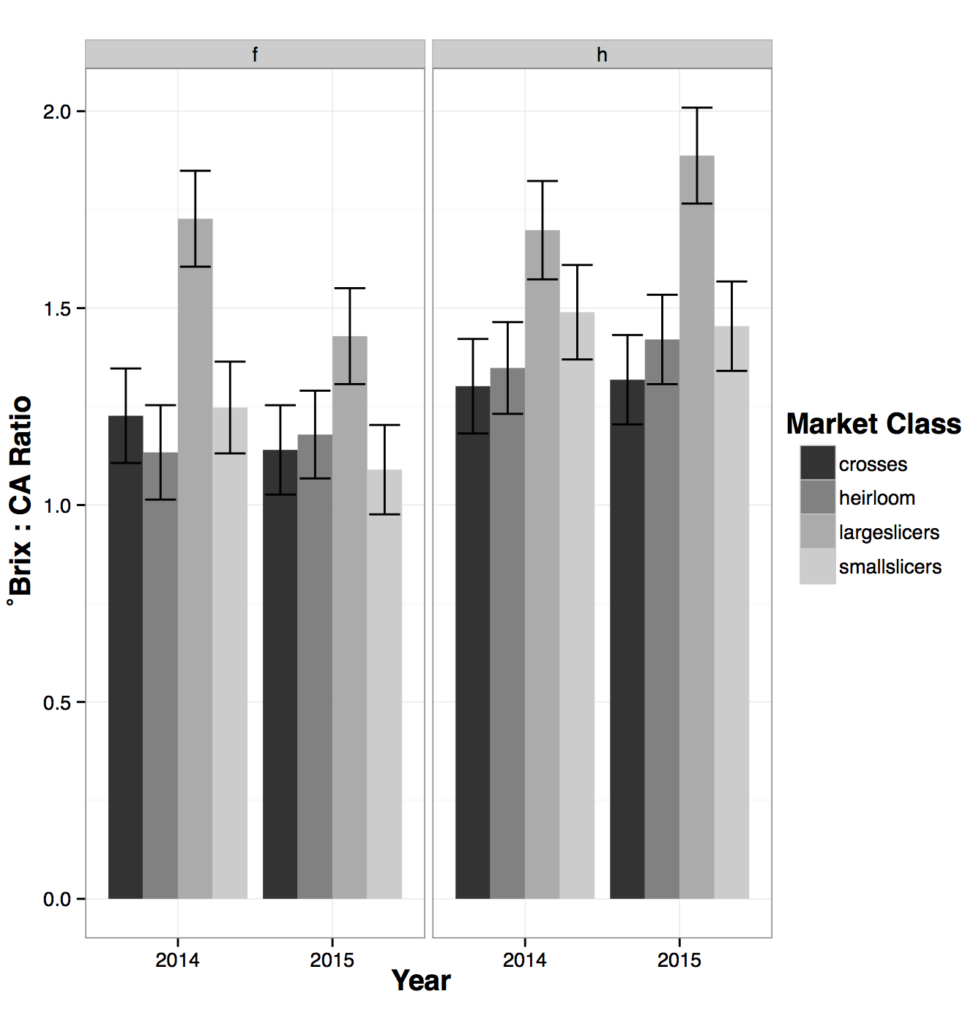 Fig 3. Ratio of ˚Brix to CA 2014-2015, in the Field (f) and High Tunnel (h). Figure from Healy et al. 2017.
Fig 3. Ratio of ˚Brix to CA 2014-2015, in the Field (f) and High Tunnel (h). Figure from Healy et al. 2017. 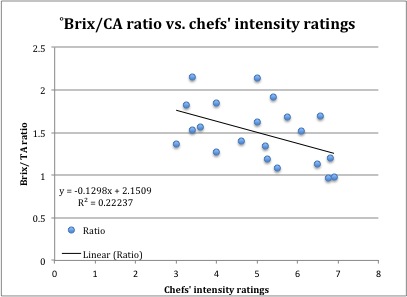 Fig. 4. Relationship between Brix:CA ratio and chef’s perception of flavor intensity. Figure from Healy et al. 2017
Fig. 4. Relationship between Brix:CA ratio and chef’s perception of flavor intensity. Figure from Healy et al. 2017
Objective 3. Evaluate flavor for each variety with a panel of chefs currently sourcing local products.
In 2016 we followed the same protocol as in 2015, with two chef flavor evaluations, August 16th and September 13th. We also conducted several public taste tests, at field days and open-house events at the West Madison Research Station (August 20th), the Spooner Agricultural Research Station (August 30th), Superior, WI (August 31st), and Stoney Acres’ farm Pizza Night (September 2nd). Results from theses flavor evaluations and the development of tasting methodology have been published in Healy’s MS Thesis and are in press as an article in Plant Breeding Reviews.
Methods:
Tomato varieties were first evaluated by members of the research staff after a simple training exercise to allow the recognition and scoring of different flavor attributes. These included sweetness, acidity, saltiness, bitterness and umami. Color and texture were also rated by staff. A mixed model analysis of variance was used to analyze data from this tasting, to determine which factors were most important in differentiating varieties. Using the variety means from the ANOVA, principal component analysis (PCA) was used to visualize the relationship among varieties using their entire flavor profile. These results were used to select a subset of varieties to be evaluated by participating chefs.
Chefs participated in a similarity-based method of descriptive analysis known as “Projective Mapping.” There is a quantitative component based on the distance samples are placed from each other and a qualitative descriptive component. Chefs independently tasted each sample and place the samples on the mapping sheet according to their perception of similarity and dissimilarity. Once placed, chefs wrote the words they associated with a variety’s flavor and texture directly on the map. Analysis of the chef tasting data is done using Multiple Factor Analysis (MFA) to produce a consensus map of how chefs view the different varieties. After completing the mapping exercise, chefs evaluate the varieties again, this time from a hedonic perspective. Questions like “would you by this for your restaurant?” “how would you use this” and “what is the best trait of this variety?” helped assess the chef’s preferences.
Results:
Preference was strongly correlated to perceived flavor intensity and less correlated to individual flavor components (figure 5). Many of the favorite tomatoes for flavor were crosses between modern and heirloom varieties selections from heirloom x heirloom variety crosses that had been selected for both performance and flavor. This is very promising for breeding efforts to combine exceptional flavor with other traits of importance to growers as it suggests that by paying attention to flavor, we can avoid compromising it when selecting for disease resistance or productivity and that these two important traits are not intrinsically a trade-off.
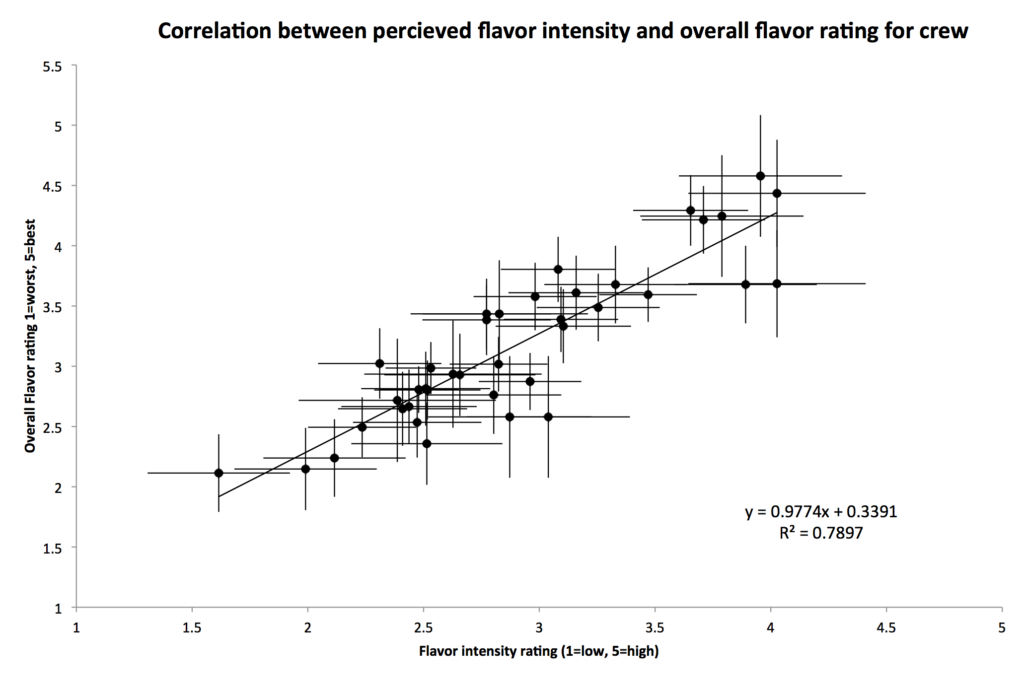 Figure 5. Correlation between perceived flavor intensity and preference. Figure from Dawson and Healy 2017.
Figure 5. Correlation between perceived flavor intensity and preference. Figure from Dawson and Healy 2017.
Objective 4. Provide data for breeders, researchers, farmers and seed companies to identify both promising varieties and traits needing improvement for the NCR
Data from these trials was summarized and distributed to contributing breeders, farmers, and chefs by email, and to the public online. Participating breeders were contacted to follow up on any questions and to request feedback on reports. All breeders felt that the reports were useful and are interested in testing other breeding lines and varieties in the trials in coming years. We identified several promising breeding lines and varieties that have good performance in the upper Midwest for productivity and flavor. We are currently writing an extension bulletin primarily for farmers in the upper Midwest, summarizing the data from three years of on-station and on-farm research.
While the varieties in the on-station trials for this project have remained constant due to the need for multiple year comparisons, we have received new breeding lines from several independent, university and seed company breeders based on results from the first years of trials and farmer evaluation and feedback. These lines are currently in screening trials at the research station and the best ones will move to on-farm trials if funding allows. In the first couple years, our screening trials had a wide range of quality and production traits, but we have seen a shift in varieties that breeders are contributing, with an increase in both quality and adaptation to the upper Midwest. We have used trial information to also identify potential parental varieties, particularly from heirloom backgrounds, for developing new varieties with quality and productivity in organic systems in the upper Midwest.
Interest in these trials from seed companies and breeders led to the submission of a successful Organic Research and Education Initiative Planning Grant, with the objective of developing a national network of vegetable variety trials focused on organic systems, following the same methodology we used in this project, with on-station trials and a complementary network of on-farm participatory trials. Breeders are very interested in the data obtained from both types of trials, with more quantitative information coming from the research station and more qualitative assessments from farmers experienced in growing the crop. A meeting was held on Feb 22nd, 2017 in Madison to develop a pilot program for a national trialing network to be conducted in 2018.
Objective 5. Develop a network of farmers, extension specialists and chefs interested in participatory research.
This network has developed and expanded faster than anticipated, and we are in the very good situation of having more farmers wanting to participate than we have seeds to distribute in 2017. In 2015, we switched to a data collection format developed by participating farmers and a flexible trialing format designed to collect information that farmers would like to know from their peers about varieties (see 2015 report). This has led to increasing numbers of farmers participating and a better rate of return for datasheets. We started with 5 farmers trialing tomatoes in 2015, 14 in 2016 and have 20 signed up in 2017. The overall network has expanded with 10 farmers returning data across all crops in 2015 and 24 returning data in 2016. We held project meetings in Madison, WI and Superior WI in Jan-Feb 2016 and Jan-Feb 2017 to get feedback on the trials from the previous season, discuss results and prioritize for the coming season. We had about 25 participants in Northern Wisconsin and 40 participants in Madison (including farmers, chefs, extension educators, plant breeders and graduate students). Collaborating with extension educators in several counties in Wisconsin has helped us recruit farmers, hold events and field days and maintain an on-the-ground presence in counties distant from Madison. We also have farmers participating in Minnesota, Michigan and Illinois and are working to build our networks in those states. We held farmer roundtable discussions at the Illinois Specialty and Organic Crops conference in January and the MOSES Organic Farming Conference in February to gather feedback on priorities for traits and crops that they would like to see us seek out from breeders for the variety trialing network.
We have also changed the format of chef evaluations based on feedback from chefs, which has increased the number of chefs participating in Madison. We have a core group of four chefs who have been part of the project for 3 years, and another 4 that have started attending regularly in 2016. The initial year’s flavor evaluations were done with 1-5 scales for different flavor components. While quantitative scales allow each variety to be compared to others for a number of flavor characteristics, the data sheets were time consuming and not very interesting to the chefs. Shifting to a similarity-based evaluation format, described above, allowed the chefs to evaluate only the most important attributes of each variety and intuitively compare varieties. The more intuitive format combined with qualitative descriptions worked well and conveyed much more information to chefs, rather than the 5-point scale, which many chefs found arbitrary and uninformative. We are working to recruit chefs in other cities with the help of farmers and extension educators around those cities.
Objective 6. Create an online database that will be easy for farmers to both access and contribute to, following the model of successful citizen science projects and participatory plant breeding trial methodology
The database component of this project has proven more complicated than initially anticipated, and we will be completing it during a no cost extension if approved. The initial goal was to identify database software with the proper framework for our trials and to customize it so that farmers, researchers and others could easily contribute to it and access project results. We have evaluated many different types of database software, and have explored three database platforms in more depth. Private-sector platforms are often not customizable and require licenses for each user or user group. We evaluated two private sector databases and decided they would not be useable for a participatory project such as this one. The public-sector and open-source databases we evaluated also had some significant drawbacks. One public sector breeding database is designed primarily for agronomic crops, so seemingly straightforward needs such as multiple harvest dates for vegetable plots are not possible without significant modifications. A second public-sector database requires much more in depth knowledge of programming than can be expected of farmers, and so we are working to see if a web interface is possible. We have partnered with the organic seed alliance and a few independent breeders to either modify one of these public-sector databases or create our own database structure from open-source tools in the first half of 2017, which would then be available to participatory breeding and trialing projects to use.
Impacts and Contributions/Outcomes
The primary impacts of this project so far is the creation of a participatory trialing network that has expanded to crops in addition to the initial tomato trials, and is also expanding to pilot a national trialing network using the same methodology. We have an increasing number of farmers interested in conducting on-farm variety trials and an increasing number of plant breeders working on organic and low input systems wanting to trial their varieties in the upper Midwest with our network.
The high-tunnel and field tomato trials have produced valuable information for farmers in the upper Midwest, which has been presented at conferences, and published in a peer review journal article for other researchers. We are summarizing data from 2014-2016 in an extension bulletin, which will include our findings on the differences in high tunnel and field production for different varieties and market classes, as well as results from the on-farm trials and flavor evaluations.
We are in the process of conducting project evaluations with participating farmers, plant breeders, and have completed interviews with participating chefs. The results from these evaluations will help us to continue to improve trial methodology.
Project results have been presented at several farmer and scientific conferences, as well as published in peer-reviewed journals. A list of outreach activities, publications and presentations is below.
Outreach activities:
Feb 3, 2016. Sensory Analysis Workshop. Organized in conjunction with the Organic Seed Growers Conference. Corvallis, OR.
August 20 Urban Horticulture Field Day. West Madison Agricultural Research Station. 200 attendees. Pouring rain.
August 30. Vegetable field day for trials. Spooner Agricultural Research Station. Attendance about 12.
September 1. Vegetable Trial Field Walk. Stoney Acres and Red Door Family Farm. Organized with Marathon County Extension. Attendance about 10.
September 11. Organic Vegetable Field Day West Madison Agricultural Research Station. About 50 people
September 15. Farm to Flavor Dinner. Organized an end of season event to highlight some of the best varieties from the season (that were still available in October) from the vegetable flavor project, with chefs Tory Miller, Dan Bonano and Jonny Hunter. Presented the project to the public and introduced them to some of the farmers, plant breeders and chefs working to improve vegetable varieties for Wisconsin and for flavor. Keynote lecture by Ken Greene, Hudson Valley Seed Library. 170 attendees.
Publications
Healy, G.K., B. Emerson and Dawson, J.C. Comparing tomato varieties for productivity and quality under organic hoop-house and open-field management. Renewable Agriculture and Food Systems. doi:10.1017/S174217051600048X
Dawson, J.C. and G.K. Healy. 2017. Flavor evaluation for plant breeders. Plant Breeding Reviews, in press.
Healy, G.K. 2016. Tomato Variety Trials, Selection and Breeding for Regional Adaptation and Culinary Quality in Organic Systems. Master of Science Thesis, Horticulture and Agroecology, University of Wisconsin-Madison.
Presentations:
Dawson, J.C. Tomato variety trials for market growers. Wisconsin Fresh Fruit and Vegetable Growers Conference. Wisconsin Dells, Jan 24 2017.
Healy, G.K. and J.C. Dawson. Tomato variety trials for flavor, quality and Agronomic Performance. NC SARE Farmers Forum, Illinois Specialty Crops, Agritourism, and Organic Conference. Jan 11-13, 2017.
Dawson, J.C. G.K. Healy and B.J. Emerson. Hoop House and Open Field Organic Tomato Trials for Productionand Quality Characteristics in the Upper Midwest. Agriculture and Natural Resources Extension Conference. Oct. 20, 2016.
Culinary Breeding Network Variety Showcase, October 3rd 2016. Portland, OR. Kitt Healy presented and sampled high-flavor tomatoes identified through our field trials, in collaboration with Jonny Hunter, one of our participating chefs. 400 attendees
Dawson, J.C. Hoop House and Open Field Organic Tomato Trials for Production and Quality Characteristics in the Upper Midwest. Annual meeting of the American Society of Horticultural Science (ASHS), Baltimore, MD. August 10th 2016.
Dawson, J.C. What makes local food different? Research to support direct-market vegetable growers. University of Wisconsin Plant Pathology Seminar Series March 14th, 2016.
Dawson, J.C. What makes local food different? Research to support direct-market vegetable growers. University of Minnesota Horticulture Seminar Series. Feb 24th, 2016.
Healy, G.K. and Dawson, J.C. Effects of High Tunnel vs. Field Production on Tomato Varieties. Wisconsin Fresh Fruit and Vegetable Growers Conference. January 25th, 2016.
Posters:
Hodge, T., G.K. Healy, B. Emerson and J.C. Dawson. 2017. Tomato Varieties for Organic High Tunnel and Field Production in the Upper Midwest. Poster Presentation at the MOSES Organic Farming Conference, La Crosse, WI, Feb 24-25, 2017.
Dawson, J.C., Healy, G.K, Theisen, T.L, Cotter, N. Hickey, T.P. Emerson, B.J. Participatory Vegetable Variety Trials and Quality Evaluation with Farmers, Consumers and Chefs. Poster Presentation at the Organic Agriculture Research Symposium. January 14 2016. Monterey, CA.
Collaborators:
Assistant Professor
University of Wisconsin-Madison
1630 Linden Dr.
Department of Plant Pathology
Madison, WI 53706
Office Phone: 6088901503